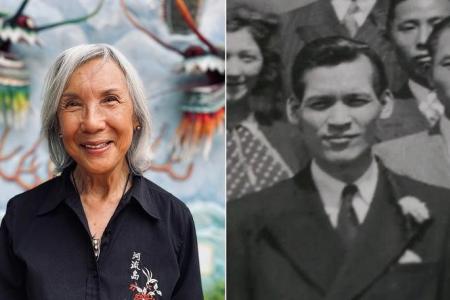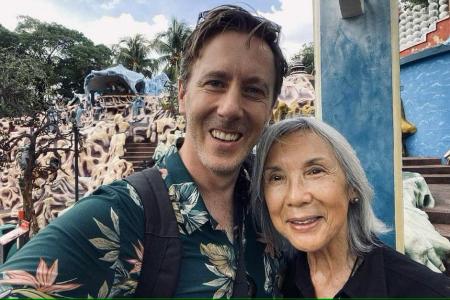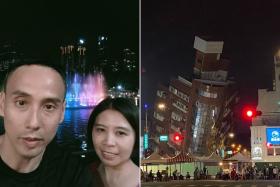British-born woman looking for likely to be '104 years old' dad
She has never been able to celebrate Father’s Day, said 79-year-old Barbara Ong Janecek, whose Chinese father was believed to have been deported to Singapore from Liverpool, Britain, in 1946 after World War II ended.
Her father, Mr John Ong, was a merchant seaman who was born around 1920. He and her Eurasian mother Eileen Hing married in Liverpool in 1943, with the marriage certificate stating that Mrs Janecek’s grandfather was a tea merchant named Lingsai Ong.
Speaking to The Straits Times over a video call from her home in Victoria, Canada, on June 11, Mrs Janecek said she has been searching for her father for more than 35 years, including calling the many John Ongs she could find.
He would be around 104 years old if he were still alive.
“As I grew older, it didn’t get any better. There is hardly a day in my life that I don’t think of him in one way or another,” said Mrs Janecek, who retired at 60 after working in jobs such as sales and banking.
Her mother was pregnant with her younger brother when her father went missing.
Unlike Mrs Janecek, her brothers, aged 80 and 77, felt that it was better to move on from the past.
“Everyone’s telling me to put the past behind me,” she said. “I know they mean well, but I find it difficult.”
The only photo she has of her dad was taken in Liverpool in 1943, showing a tall and handsome man at a wedding.
Her mother’s cousin said he spoke good English, played the violin and piano, and rode a motorcycle. She was not sure about his birthplace, or when he relocated to Britain.
Added Mrs Janecek: “What was lovely to hear was that he was very generous to my mum, charming and full of fun.”
Her late mother hardly talked to her about her father.
Mrs Janecek later read about the forced repatriation of thousands of Chinese sailors from Britain as part of its post-war reconstruction, and how their sudden departure had a devastating effect on families left behind.
The family was destitute after his disappearance, and always went hungry, added Mrs Janecek. They lived in the basement of a dilapidated Victorian house in Upper Stanhope Street in Liverpool.
Her mother, who spent her evenings working in a Chinese restaurant to make ends meet, lived mostly on credit. She would send her three children to the corner shop to ask for scraps such as broken biscuits.
She married a Chinese man, her husband’s friend, in 1952.
The sudden disappearance of her father affected Mrs Janecek’s life decisions. She left Liverpool to go to Canada when she was 19 and married a Czech man 18 years her senior. She was looking for a father figure, she said.
Soon after her mother died in 1973, a Chinese man walked into her younger brother’s fish and chips shop in Liverpool. He said their father knew all about the family and their whereabouts. However, her brother asked the man to leave, thinking that his father had abandoned the family.
“I was very upset when I found out. It was a lost opportunity and I think my dad was reaching out to us,” said Mrs Janecek, who has three middle-aged sons with her late husband.
She has visited Singapore several times in the past as a tourist.
In December 2023, she was here again, this time with Mr Tom St John Gray, a British freelance documentary director who featured her and others in a recent documentary on deported Chinese seamen from Liverpool.
Mr St John Gray, 44, said her story captivated him because she is a warm and kind-hearted person, but he sensed “the painful linger of a terrible injustice”.
He added that declassified records in London’s National Archives prove that thousands of Chinese men were deported from Liverpool, with hundreds covertly transported to Singapore. This happened after more than 20,000 Chinese seamen served on ships on missions across the Atlantic, bringing essential supplies to Britain during the war. Many left their old lives behind and were forced to start anew, with second families whose members grew up knowing nothing of the past.
“It’s very possible many thousands of young Singaporeans today are related to this astonishing story without ever knowing it,” Mr St John Gray said. “And one of those many thousands might hold Barbara’s missing puzzle piece.”
He took Mrs Janecek to Boat Quay as well as Clifford Pier, a possible landing site for the deported seamen in 1945 and 1946. They explored the Thian Hock Keng temple for its seafaring roots, and wandered through Bukit Brown, where she was excited to see tombs linked to the Ongs.
“I feel a sense of belonging in Singapore,” she said. “The visits gave me a great sense of peace and connectedness.”
A few weeks after she left Singapore, Mr St John Gray found a message in the personal column of the Liverpool Echo newspaper from 1955. It was a request by Mrs Janecek’s mother and stepfather for Mr John Ong, who was sometimes known as “Ong Ah Mow”, to contact them.
Mr Nathan Co, a Singaporean from Facebook group Chinese Ancestry Research, said Mr Ong is most likely Hokkien, and the challenge of finding him is that there are many going by the name of John Ong in Singapore. Mr Co, whom Mr St John Gray contacted for help, approached the Ong clan associations, but has not received any response.
“My father was a young man who was probably 26 or 27 when he left us,” said Mrs Janecek. “I would feel peace of mind knowing that he went on to have a normal life and had a family that loved him.”
This Father’s Day, she would like to let him know how grateful she is to be his daughter, and how she loves and misses him very much.
“If there’s a life after this, I would still love him.”
Get The New Paper on your phone with the free TNP app. Download from the Apple App Store or Google Play Store now



